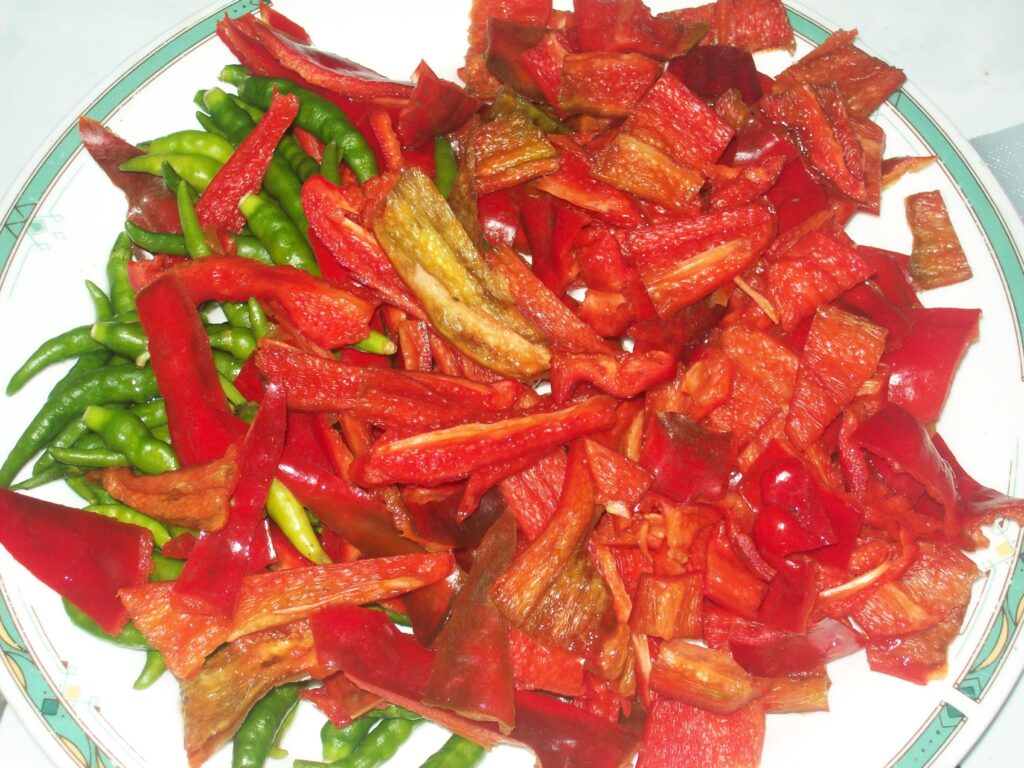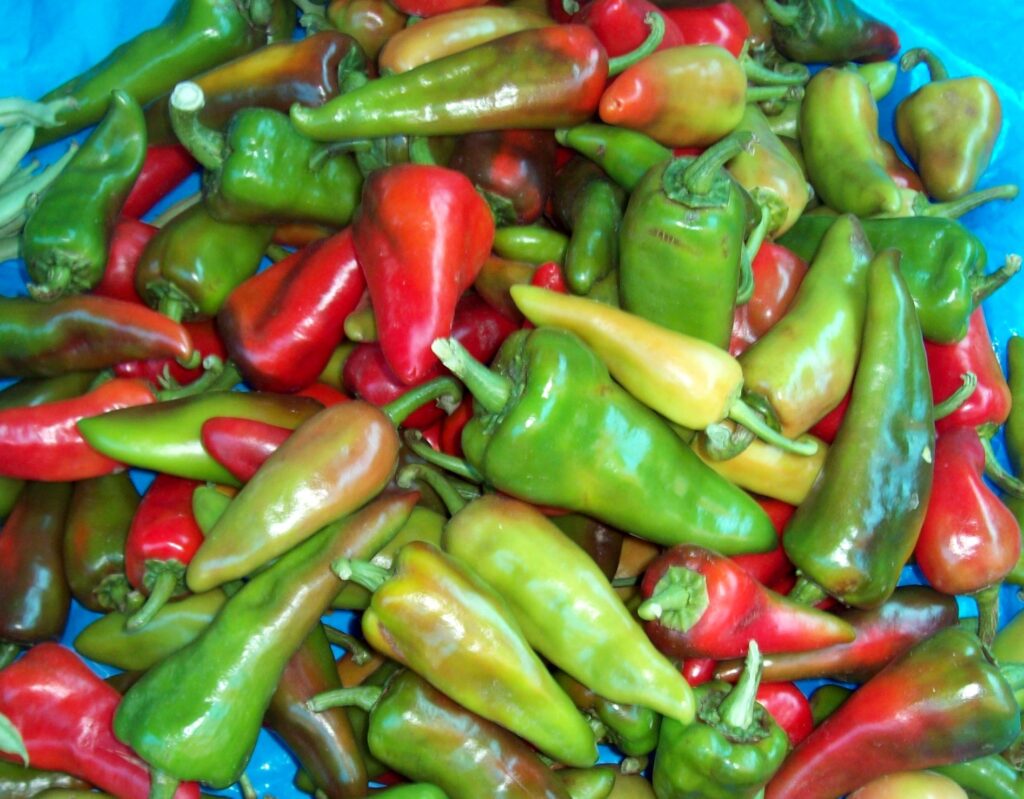Text and Photos by Henrylito D. Tacio
Peppers are native to Mexico, Central America, and northern South America. Pepper seeds were later carried to Spain in 1493 and from there spread to other European, African, and Asian countries.
The misleading name “pepper” (pimiento in Spanish) was given by world explorer Christopher Columbus upon bringing the plant back to Europe. At that time, peppercorns, the fruit of black pepper (Piper nigrum), an unrelated plant originating from India, were a highly prized condiment; the name “pepper” was at that time applied in Europe to all known spices with a hot and pungent taste and so naturally extended to the newly discovered Capsicum genus.
Sweet pepper is a member of the Capsicum genus. Botanically, sweet peppers are fruits, but they are generally considered in culinary contexts as vegetables. When cut off, the top of the sweet pepper is referred to as a “pepper pan.”
In British English, the fruit is simply referred to as a “pepper,” or additionally by color (as in the term “green pepper.” for example). In other countries like Australia, India, Malaysia, and New Zealand, it is called “capsicum.”
In the Ohio Valley, people sometimes refer to sweet peppers as mangos. This has been explained by the practice of pickling the fruit known as a mango when it was imported to the American colonies in the 1600s, before refrigeration. At some point, any fruit which was pickled was called “mango.” Sweet peppers were sometimes pickled, so they were called mangos.
Unlike its distant relative, hot or chili pepper, sweet pepper does not produce capsaicin, a lipophilic chemical that can cause a strong burning sensation when it comes in contact with mucous membranes. The lack of capsaicin in sweet pepper is due to a recessive form of a gene that eliminates capsaicin and, consequently, the “hot” taste usually associated with the rest of the Capsicum genus.

Sweet peppers are processed mostly as pickled peppers. Fresh sweet peppers are a common part of tossed salads and relish trays; they are particularly tasty when stuffed with any of a vast number of mixtures of meat and vegetables.
They come in various colors: green, red, yellow, orange, and more rarely, white, rainbow (between stages of ripening), and purple, depending on when they are harvested and the specific cultivar.
Experts say green peppers are less sweet and slightly more bitter than red, yellow, or orange peppers. The taste of ripe peppers can also vary with growing conditions and post-harvest storage treatment; the sweetest are fruit allowed to ripen fully on the plant in full sunshine, while fruit harvested green and after-ripened in storage are less sweet.
What’s in a sweet pepper?
According to nutritionists, red peppers have more vitamins and nutrients and contain the antioxidant lycopene compared to green peppers. The level of carotene, another antioxidant, is nine times higher in red peppers. Red peppers have twice the vitamin C content of green peppers. Also, one large red sweet pepper contains 209 milligrams of vitamin C, which is more than double the 98 milligrams in one large citrus orange.
A study of ten different vegetables, published in the Journal of Agricultural and Food Chemistry, found that red sweet peppers had the highest total antioxidant activity of those studied. Broccoli, carrots, spinach, cabbage, yellow onions, celery, potatoes, lettuce, and cucumber followed red sweet peppers – in that order.
Unknowingly, sweet peppers have been used for their medicinal values since ancient times but have only recently been documented by medical science. Studies found that sweet peppers are a fair skin purifier and control gas in the stomach and intestine. They are also good for stomach ache, sore throat, scarlet fever, indigestion, yellow fever, diarrhea, piles, hypertension, or high blood pressure.
Sweet peppers are likewise very effective in preventing blood clots (which prevent strokes) and helping health, repair, and strengthen the lining of the mucous membranes to prevent nose bleeds. Likewise, the high vitamin C and beta-carotene make sweet pepper especially beneficial in preventing eye problems like astigmatism, cataracts, and macular degeneration.
Growing sweet pepper
For farmers who want to plant sweet pepper, they should plant the crop in sandy or sandy loam soil that is well-drained, mellow, loose, and rich in organic matter. The soil pH should be between 5.5 and 6.8, according to the Asian Vegetable Research and Development Center (AVRDC).
Sweet pepper can be planted in both dry and wet seasons since it can tolerate a range of climates – from warm, temperate to tropical. However, it cannot stand waterlogged areas. When planted during the rainy season, the field should be properly drained.
“Growing sweet peppers in a different season or under a different rotation system might provide higher yields and/or higher prices,” the AVRDC notes. “Relay or intercropping might provide extra income from the same piece of land, and reduce insect and disease problems. Calculate potential returns, and choose the variety and cropping system that serve you best.”

Sweet peppers are commonly propagated by seeds. There are two things that should be done to ensure a good harvest of quality sweet pepper fruits. First, the seeds to be planted must be free from diseases. Second, the seeds must be treated before sown.
The seedlings must be planted first in a seedbed or seedbox before they are planted in the field. Seven to days before transplanting, the seedlings are hardened first. The most practical method of hardening is by direct exposure to sunlight and a gradual reduction in watering both in amount and frequency.
Land preparation. The land must be thoroughly prepared by mechanical means or with the use of animal-drawn implements. For slightly rolling areas, contour plowing is highly recommended. Big clods of the soil must be broken.
Transplanting. Seedlings are ready for transplanting four weeks after sowing. Transplanting is done in the late afternoon or on a cloudy day to minimize transplant shock. Each plant is buried half its total height (root to tip) and immediately irrigated after transplanting.
Mulching. Whether planted during the dry or rainy season, it is necessary that the spot where the seedlings have been transplanted be mulched with dry leaves or rice straw. Mulching is more effective when done right after transplanting the seedlings.
Weeding. Weeds must be controlled to attain maximum crop yield. If mulching can’t be practiced, cultivation may be employed. Cultivation also helps plants absorb water and improves soil aeration.
Irrigation. Sweet peppers need moderate irrigation—lack of moisture in the soil results in poor yield. But during the rainy season, it is important to build drainage canals because sweet peppers are fairly shallow-rooted and have a low tolerance to flooding. They generally wilt and die if they stand in water for very long.
Fertilization. In the absence of soil analysis, the recommended fertilizers for one hectare are 60 kilograms of nitrogen, 130 kilograms of phosphorus, and 95 kilograms of potassium. Half of this is applied as a basal application before planting. The remaining half is applied as side-dressing one month after planting. If commercial fertilizers are not available in the area, compost, manures, or leaves of nitrogen-fixing trees (kakawate or ipil-ipil) may be used.
Pruning. To maximize production, prune the stems of the plants which are not productive. Pruning must be done carefully with a sharp knife or pruning shears.
Pest and disease management. Like most crops, sweet peppers are attacked by pests and diseases. Integrated pest management (IPM) should be followed. IPM has many components, including good hygiene, field scouting, mechanical control, cultural practices, biological control, and chemical control.
Harvesting. Harvesting is dictated by the market. For example, if sweet pepper is intended for immediate use, “red ripes” are preferred but are intended for distant markets, “green wraps” are the choice. If intended for nearby markets, “breakers” or “pinks” are preferred.
“Green wraps” are distinguished by shiny green fruit about to ripen; “breakers” by the discoloration (change of color) around the blossom end; “pinks” by the ripening of half of the fruit; and “red ripes” by fully ripe sweet pepper intended to be sold immediately.
Usually, it takes 34-50 days from flowering to the optimum harvest stage. For most sweet pepper varieties, production usually lasts 6-8 weeks (3-4 harvest as fruits ripen)

